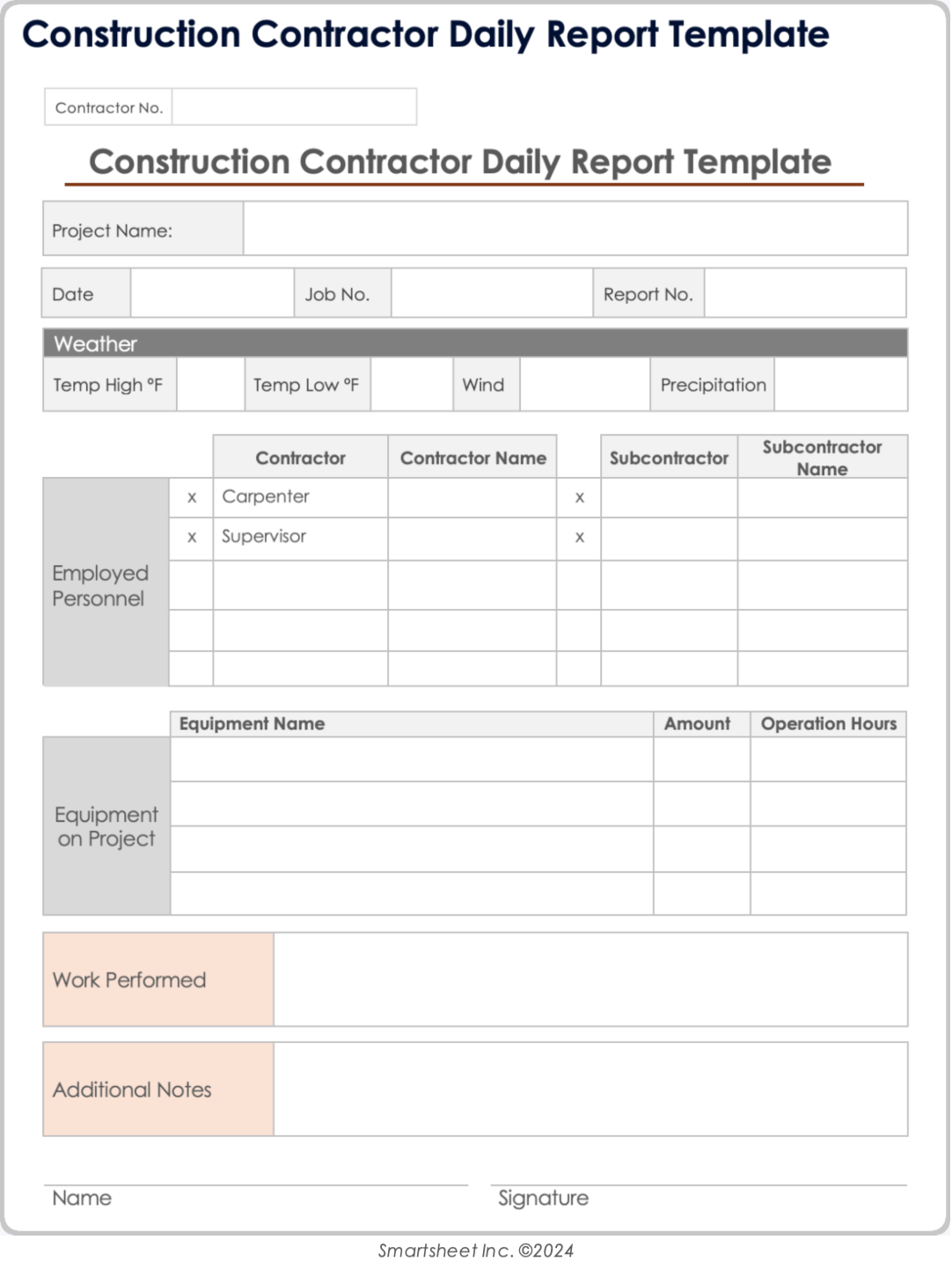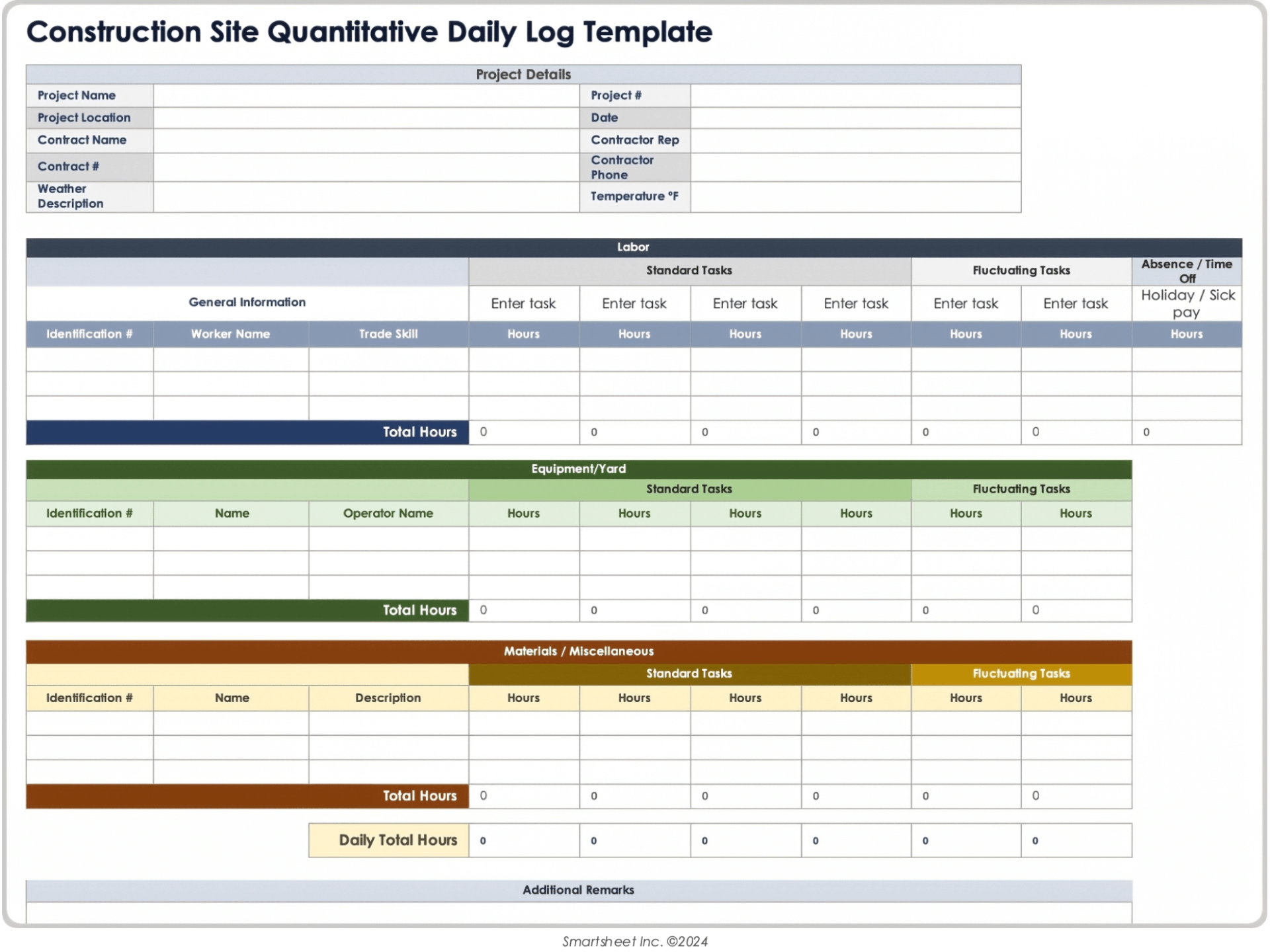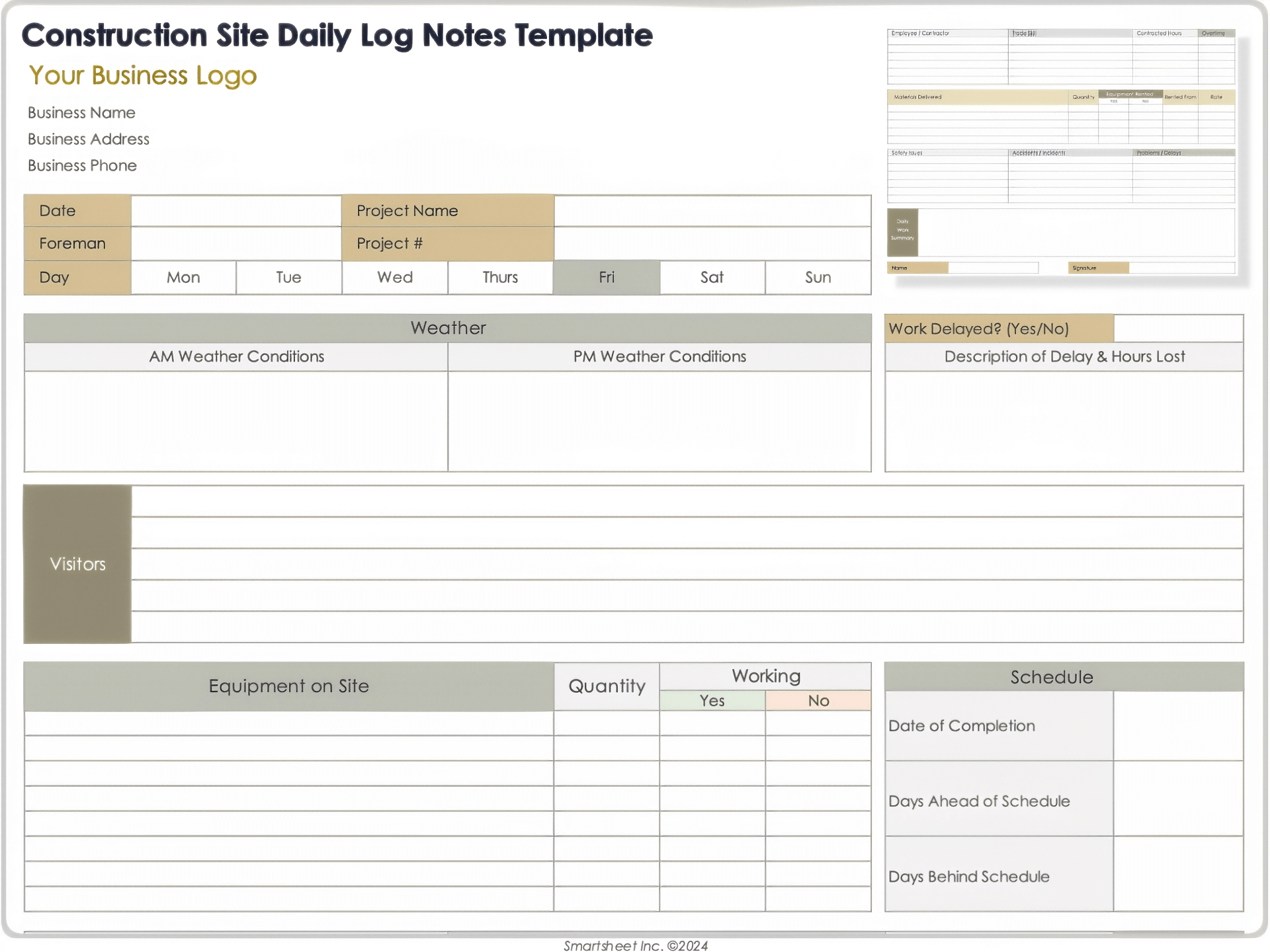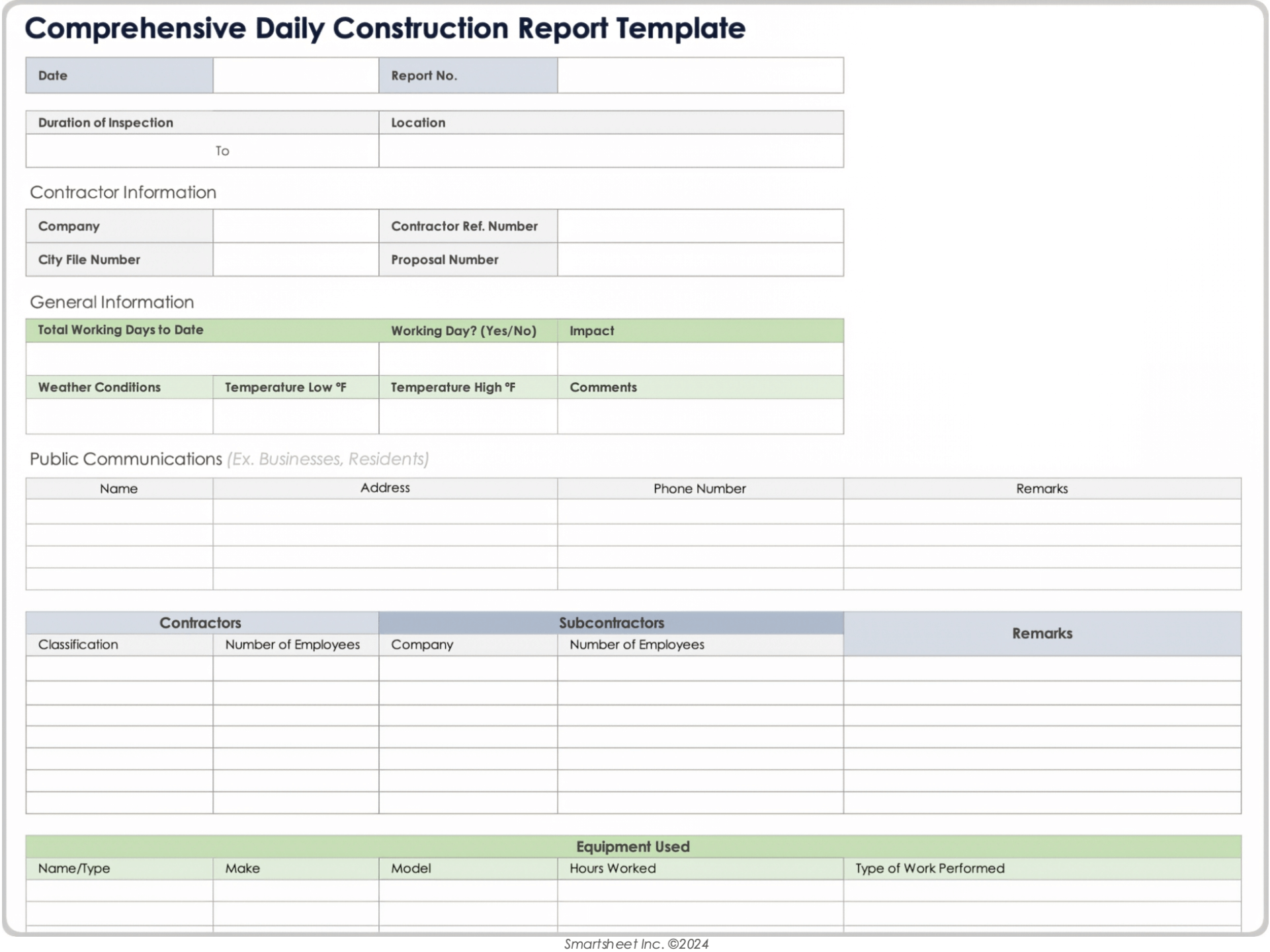Construction Daily Report Template

Download a Construction Daily Report Template for
Excel
|
Microsoft Word
| Google Docs | Google Sheets
When to Use This Template: Use this template to provide a comprehensive overview of the day, including all construction events, delays, meetings, deliveries, and other activities, alongside your basic construction daily report covering crew, equipment, materials, and associated hours.
Notable Template Features: This template includes essential details such as weather, equipment, hours, and attendee information. It includes additional sections for noting safety inspections, visitors, meetings, materials, and delays, providing a full scope of the day’s events. Check out these construction daily report templates for more useful documents and information.
On-Site Inspection Construction Daily Log Template

Download an On-Site Inspection Construction Daily Log Template for
Excel
|
Microsoft Word
|
Adobe PDF
| Google Docs | Google Sheets
When to Use This Template: Use this printable template for on-site check-ins and evaluations of a construction site. It allows you to document workers on-site, equipment used, equipment condition, delivered materials, and visitors. You can also describe the status of the project and any issues with the contractor or site representative.
Notable Template Features: This template provides space to note the weather, worker names and roles, materials, and machine hours. It also provides ample space for describing on-site equipment in detail.
Find more daily progress report templates for use in any kind of project.
Construction Contractor Daily Report Template

Download a Construction Contractor Daily Report Template for
Microsoft Word
|
Adobe PDF
| Google Docs
When to Use This Template: Use this template to quickly capture the essential facts of the day. It is designed for recording the number of contractors working, the quantity of equipment used, and the corresponding hours of usage, as well as describing the work performed.
Notable Template Features: This template includes detailed weather information, such as temperature highs, lows, and precipitation measurements. It lists personnel, equipment, and hours used, as well as provides space for a qualitative description of the work performed, allowing for more detailed analysis.
Construction Site Quantitative Daily Log Template

Download a Construction Site Quantitative Daily Log Template for
Excel
|
Microsoft Word
|
Adobe PDF
| Google Docs | Google Sheets
When to Use This Template: Use this template to track daily tasks, who completed them, how long they took, and what equipment and materials were used. This template focuses on tasks and the resources required to complete them.
Notable Template Features: This template separates regular tasks from abnormal ones and accounts for who performed each, their role, and the hours they worked. It provides a clear overview of task assignments, durations, and the equipment and materials involved.
Construction Site Daily Log Notes Template

Download a Construction Site Daily Log Notes Template for
Excel
|
Microsoft Word
| Google Docs | Google Sheets
When to Use This Template: Use this template to provide detailed accounts of the day’s events. Each section includes ample space to record information and describe each element thoroughly.
Notable Template Features: This template provides space to report any hours lost due to bad weather, as well as detailed morning and afternoon weather descriptions. It also provides space to describe problems, delays, accidents, incidents, and safety issues, rather than just listing them. Additional features include sections for recording overtime hours and a qualitative summary of the day’s work, which is useful for capturing extra details and offering leadership a concise overview of progress.
Comprehensive Daily Construction Report Template

Download a Comprehensive Daily Construction Report Template for
Excel
|
Microsoft Word
| Google Docs | Google Sheets
When to Use This Template: Use this template to track on- and off-site activities. Off-site activities might include public interactions or coordination with outside agencies.
Notable Template Features: This template has all the basics, plus a section for recording communications with the public, subcontractors onsite, and qualitative descriptions of work activity, comments, and coordination with outside agencies. It also provides a section for detailing the equipment used, allowing you to note the machine make, type, model, type of work performed, and hours worked.
Learn more about construction submittals and how to manage them. Then, check out these free construction submittal templates for help getting started.
Different Types of Daily Construction Logs
In addition to contractor and inspector daily construction logs, daily logs can sometimes be divided into specific types to cover all aspects of the day. These may include a work log, safety log, visitor log, delivery log, delay log, project summary log, and more.
- Contractor Log: Contractor logs include all the basics to report on the day. They contain information on weather, crew members, work tasks, equipment, materials, and daily summaries.
- Inspector Log: Inspector logs are similar to contractor logs, as they list who is working and what equipment was used. However, they focus more on describing the quality of the equipment, task progress, and any contractor issues.
- Work Log: A work log describes the work completed that day. It includes details on what equipment and materials were used, who completed the work, and how long it took.
- Safety Log: A safety log details the safety precautions undertaken that day. It also includes space for recording workplace safety incidents.
- Visitor Log: A visitor log allows teams to document the names of all visitors to the job site, as well as their reasons for visiting.
- Delivery Log: The delivery log lists all material deliveries to the job site, including their name and quantity of the materials, the time of delivery, and the identity of the delivery personnel.
- Delay Log: A delay log details all delays experienced on the job, how long they lasted, when they occurred, and why they happened.
- Project Summary Log: A project summary log provides a comprehensive overview of the day, focusing on the work completed and any issues that arose.
Basic Elements in All Daily Construction Logs
All daily construction logs should include the information needed for a clear and comprehensive record of the day’s activities. This includes details such as the name, date, and location of the project; weather information; crew members present; work tasks performed; equipment and materials used; and more.
- Basic Details: Include the contractor’s name, the date of the log, and the location of the job site.
- Weather Information: Record relevant weather information such as temperature or inclement weather. Separate the details into morning (AM) and afternoon (PM) for clarity.
- Crew Members: List all workers present, their job titles, the tasks they worked on, and the number of hours they worked.
- Work Tasks: Write a detailed description of the tasks performed during the day. Include who performed each task, what equipment or materials were used, and how long each task took to complete.
- Equipment: Document the equipment used, noting the name, condition, and duration of use for each.
- Materials: List all materials used, specifying the quantities and the tasks they were used for.
- Summary: Write a summary of the work completed that day, as well as any delays or issues that arose.
Learn more about construction management with these construction project management templates for Excel and construction schedule templates.
Keep Construction Projects on Track With Real-Time Work Management in Smartsheet
From pre-construction to project closeout, keep all stakeholders in the loop with real-time collaboration and automated updates so you can make better, more informed decisions, all while landing your projects on time and within budget.
The Smartsheet platform makes it easy to plan, capture, manage, and report on work from anywhere, helping your team be more effective and get more done. Report on key metrics and get real-time visibility into work as it happens with roll-up reports, dashboards, and automated workflows built to keep your team connected and informed.
When teams have clarity into the work getting done, there’s no telling how much more they can accomplish in the same amount of time. Try Smartsheet for free, today.